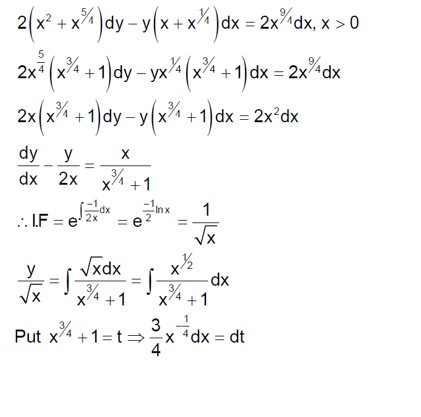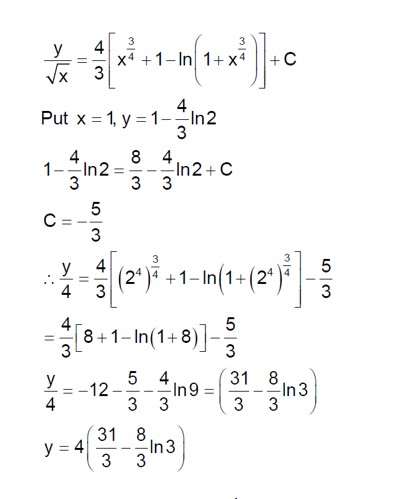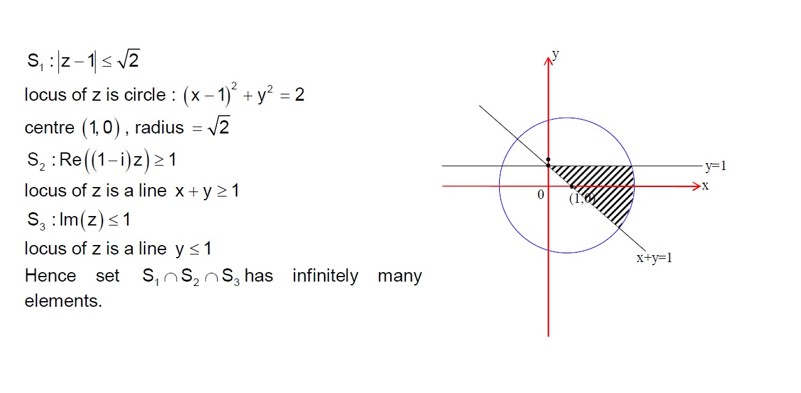Ncert Solutions Maths class 11th
Get insights from 1.6k questions on Ncert Solutions Maths class 11th, answered by students, alumni, and experts. You may also ask and answer any question you like about Ncert Solutions Maths class 11th
Follow Ask QuestionQuestions
Discussions
Active Users
Followers
New answer posted
2 months agoContributor-Level 10
I = ∫[0 to 10] [sin(2πx)] / e^(x-[x]) dx.
The period of the integrand involves [sin(2πx)] which depends on the sign of sin(2πx) and {x} = x - [x], which has a period of 1.
Let f(x) = [sin(2πx)] / e^{x}.
The integral is ∫[0 to 10] f(x) dx = 10 * ∫[0 to 1] f(x) dx due to the periodicity of {x} and the integer period of sin(2πx).
In the interval (0, 1/2), sin(2πx) is between 0 and 1, so [sin(2πx)] = 0.
In the interval (1/2, 1), sin(2πx) is between -1 and 0, so [sin(2πx)] = -1.
At x=0, 1/2, 1, the value is 0.
So, ∫[0 to 1] f(x) dx = ∫[0 to 1/2] 0 dx + ∫[1/2 to 1] -1/e^x dx
= 0 + [-e^(-x) * (-1)] from 1/2 to 1 = [e^(-x)] from 1
New answer posted
2 months agoContributor-Level 10
Parabola: y² = 4x - 20 = 4(x - 5). Vertex at (5,0).
Line: The text seems to derive the tangent equation y = x - 4. This is not a tangent to the given parabola. The standard tangent to y²=4aX is Y=mX+a/m. Here X=x-5, a=1. So y = m(x-5)+1/m.
The other curve is an ellipse: x²/a² + y²/b² = 1.
The text says x²/2 + (x-4)²/b² = 1. This assumes a² = 2.
x²/2 + (x²-8x+16)/b² = 1
x²(1/2 + 1/b²) - (8/b²)x + (16/b² - 1) = 0.
For tangency, the discriminant (D) of this quadratic equation must be zero.
D = (8/b²)² - 4(1/2 + 1/b²)(16/b² - 1) = 0.
64/b? - 4(8/b² - 1/2 + 16/b? - 1/b²) = 0.
16/b? - (7/b² - 1/2 + 16/b?) = 0.
-7/b² + 1/2 = 0
New answer posted
2 months agoContributor-Level 10
P(O at even place) = 1/2, P('O' at odd place) = 1/3
P(1 at even place) = 1 - 1/2 = 1/2
P(1 at odd place) = 1 - 1/3 = 2/3
The probability that 10 is followed by 01 is given by a sequence of probabilities, which seems to represent a specific arrangement or transition. The calculation is:
P(10 is followed by 01) = (2/3) * (1/2) * (1/3) * (1/2) * (1/2) * (1/3) * (1/2) * (2/3) = 1/18 + 1/18 = 1/9.
The calculation seems incomplete or context is missing.
New answer posted
2 months agoContributor-Level 10
- Given vectors OP = xi + yj - k and OQ = -i + 2j + 3xk.
- PQ = OQ - OP = (-1 - x)i + (2 - y)j + (3x + 1)k
- Given |PQ| = √20, so |PQ|² = 20.
(-1 - x)² + (2 - y)² + (3x + 1)² = 20
(1 + x)² + (2 - y)² + (3x + 1)² = 20 .(i) - Given OP ⊥ OQ, so OP · OQ = 0.
(x)(-1) + (y)(2) + (-1)(3x) = 0
-x + 2y - 3x = 0 ⇒ -4x + 2y = 0 ⇒ y = 2x .(ii)
Substitute (ii) into (i):
(1 + x)² + (2 - 2x)² + (3x + 1)² = 20
1 + 2x + x² + 4 - 8x + 4x² + 9x² + 6x + 1 = 20
14x² = 14 ⇒ x² = 1 ⇒ x = ±1.
When x = 1, y = 2. When x = -1, y = -2.
So, (x, y) can be (1, 2) or (-1, -2).- Given that OR, OP, and OQ are coplanar, their scalar triple product is 0: [OR OP OQ]
- Given OP ⊥ OQ, so OP · OQ = 0.
New question posted
2 months agoNew answer posted
2 months agoContributor-Level 10
f (x) = ∫ (5x? + 7x? ) / (x² + 1 + 2x? ) dx seems to have a typo in the denominator. Based on the solution, the denominator is (x? + 1/x? + 2)² or similar. Let's follow the solution's steps.
It seems the denominator is (x? (2 + 1/x? + 1/x? )² = x¹? (2 + 1/x? + 1/x? )².
f (x) = ∫ (5x? + 7x? ) / (x¹? (2 + 1/x? + 1/x? )²) dx
The solution simplifies the integrand to:
f (x) = ∫ (5/x? + 7/x? ) / (2 + 1/x? + 1/x? )² dx
Let t = 2 + 1/x? + 1/x?
dt = (-5/x? - 7/x? ) dx = - (5/x? + 7/x? ) dx.
The integral becomes:
f (x) = ∫ -dt / t² = 1/t + C.
f (x) = 1 / (2 + 1/x? + 1/x? ) + C.
Given f (0)=0, this form has a division by zero. Let's re-ex
New answer posted
2 months agoContributor-Level 10
Evaluate the limit:
L = lim (x→0) [sin? ¹ (x) - tan? ¹ (x)] / 3x³
Using Taylor series expansions around x=0:
sin? ¹ (x) = x + x³/6 + O (x? )
tan? ¹ (x) = x - x³/3 + O (x? )
L = lim (x→0) [ (x + x³/6) - (x - x³/3) ] / 3x³
L = lim (x→0) [ x³/6 + x³/3 ] / 3x³
L = lim (x→0) [ (1/6 + 1/3)x³ ] / 3x³
L = (1/2) / 3 = 1/6
The solution shows 3L = 1/2, which is correct. And 6L = 1, also correct.
The final line 6L+1=2 implies 6L=1, confirming the result.
New answer posted
2 months agoContributor-Level 10
Given the determinant:
| α β γ |
| β γ α | = 0
| γ α β |
The expansion of this determinant is - (α³ + β³ + γ³ - 3αβγ) = 0.
This implies (α+β+γ) (α²+β²+γ²-αβ-βγ-γα) = 0.
From a cubic equation x³ + ax² + bx + c = 0 with roots α, β, γ:
α+β+γ = -a
αβ+βγ+γα = b
αβγ = -c
Substituting into the determinant condition:
(-a) ( (α+β+γ)² - 3 (αβ+βγ+γα) ) = 0
(-a) ( (-a)² - 3b ) = 0
-a (a² - 3b) = 0
a (a² - 3b) = 0
This implies a=0 or a²=3b. If a≠0, then a²=3b, so a²/b = 3.
Taking an Exam? Selecting a College?
Get authentic answers from experts, students and alumni that you won't find anywhere else
Sign Up on ShikshaOn Shiksha, get access to
- 65k Colleges
- 1.2k Exams
- 679k Reviews
- 1800k Answers



